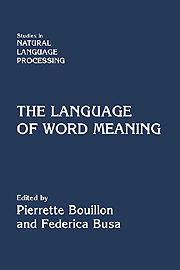Book contents
- Frontmatter
- Contents
- List of Contributors
- Preface
- Introduction: Word Meaning and Creativity
- Part I Linguistic Creativity and the Lexicon
- Part II The Syntax of Word Meaning
- Part III Interfacing the Lexicon
- 13 Introduction
- 14 Metaphor, Creative Understanding, and the Generative Lexicon
- 15 Metaphor in Discourse
- 16 Syntax and Metonymy
- 17 Generative Lexicon Meets Corpus Data: The Case of Nonstandard Word Uses
- Part IV Building Resources
- Index
17 - Generative Lexicon Meets Corpus Data: The Case of Nonstandard Word Uses
Published online by Cambridge University Press: 07 October 2011
- Frontmatter
- Contents
- List of Contributors
- Preface
- Introduction: Word Meaning and Creativity
- Part I Linguistic Creativity and the Lexicon
- Part II The Syntax of Word Meaning
- Part III Interfacing the Lexicon
- 13 Introduction
- 14 Metaphor, Creative Understanding, and the Generative Lexicon
- 15 Metaphor in Discourse
- 16 Syntax and Metonymy
- 17 Generative Lexicon Meets Corpus Data: The Case of Nonstandard Word Uses
- Part IV Building Resources
- Index
Summary
Abstract
There are various ways to evaluate the Generative Lexicon (GL). One is to see to what extent it accounts for what we find in text corpora. This has not previously been done, and this chapter presents a first foray. The experiment looks at the ‘nonstandard’ uses of words found in a sample of corpus data: “nonstandard” is defined as not matching a literal reading of any of the word's dictionary definitions. For each nonstandard instance we asked whether it could be analyzed using GL strategies. Most cases could not. The chapter discusses in detail a number of nonstandard uses and presents a model for their interpretation that draws on large quantities of knowledge about how the word has been used in the past. The knowledge is frequently indeterminate between “lexical” and “general,” and is usually triggered by collocations rather than a single word in isolation.
Introduction
The GL claims to be a general theory of the lexicon. Pustejovsky identifies “the creative uses of words in novel contexts” (Pustejovsky, 1995, p. 1) as one of two central issues which GL addresses, where other formal theories have remained silent. He asserts as a principle that “a clear notion of semantic well-formedness will be necessary in order to characterise a theory of possible word meaning“ (ibid, p. 6) and identifies a generative lexicon as a framework in which a core set of word senses is used to generate a larger set, according to a set of generative devices. Most work in the GL tradition has been concerned to identify and formally specify those devices.
- Type
- Chapter
- Information
- The Language of Word Meaning , pp. 312 - 328Publisher: Cambridge University PressPrint publication year: 2001
- 7
- Cited by



